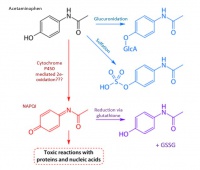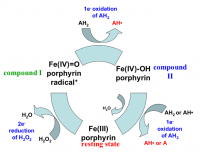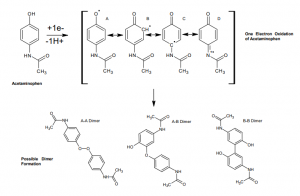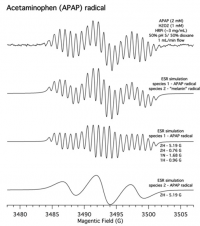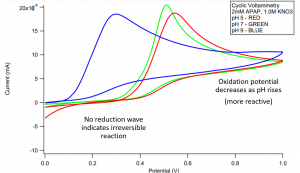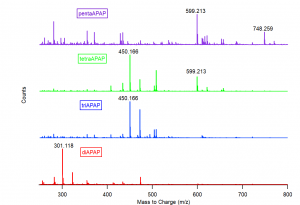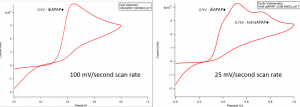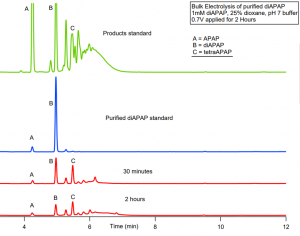Difference between revisions of "Acetaminophen Induced Toxicity"
| Line 65: | Line 65: | ||
[[File:APAPCV.png|300px|thumb|right|APAP Cyclic Voltammetry with pH gradient (Figure 4)]] | [[File:APAPCV.png|300px|thumb|right|APAP Cyclic Voltammetry with pH gradient (Figure 4)]] | ||
| + | [[File:MS4wiki.png|300px|thumb|left|qTOF-MS visualized APAP Polymerization]] | ||
[[File:diAPAPCVexp.png|300px|thumb|right|diAPAP Cyclic Voltammetry (Figure 4)]] | [[File:diAPAPCVexp.png|300px|thumb|right|diAPAP Cyclic Voltammetry (Figure 4)]] | ||
Revision as of 18:06, 16 December 2021
An Alternative Mechanism of Acetaminophen Induced Hepatotoxicity
Matthew W. Simonson, Bradley E. Sturgeon
Monmouth College, Department of Chemistry
Abstract
Acetaminophen (APAP) is a common analgesic and an active ingredient in many painkillers such as Tylenol and Percocet. APAP misuse can lead to Acetaminophen Induced Liver Injury (AILI), which accounts for a striking proportion of acute liver failures in the United States. Better understanding of how APAP toxicity disseminates provides insight into alternative treatments for APAP overdose. Research in our group is focused on investigating the potential one electron oxidation products of the cytochrome P450 (CYP) catalyzed reaction involving APAP under saturated glutathione conditions with the goal of better understanding the pathophysiology behind AILI. This has been investigated by using Horseradish peroxidase (HRP) as an enzyme to model the effects of CYP in order to catalyze the one electron oxidation of APAP with hydrogen peroxide. High Performance Liquid Chromatography (HPLC) was utilized to characterize the oxidation products of this reaction, which resulted in the formation of aqueous insoluble APAP polymers with a reactive radical intermediate as indicated by electron spin resonance (ESR). Cyclic voltammetry was also used to characterize APAP and its early oxidation products by their oxidation potential and the capability of compound I and compound II to oxidize them as a part of the Peroxidase enzymatic cycle. Our findings have important implications in understanding the potential one electron oxidation mechanism by which AILI propagates and deals damage within the liver under times of APAP overdose.
Introduction
Seemingly harmless in normal dosages, large quantities of APAP can result in liver necrosis by depleting glutathione reserves in a dose dependent manner (). APAP misuse is responsible for approximately 50% of acute liver failure cases in the United States (). Treatments for Acetaminophen Induced Liver Injury (AILI) are limited and ineffective if not caught early enough. Considering this and the widespread use of APAP containing pharmaceuticals, it is imperative that the mechanism of acetaminophen induced hepatotoxicity be revisited.
The current accepted mechanism by which AILI presents itself is through a two electron oxidation as illustrated in Figure 1. Under normal conditions, APAP is mostly converted to nontoxic metabollites via sulfation or glucuronidation while a small percentage is oxidized by cytochromes P-450 to the proposed two electron oxidation product and highly reactive metabollite, N-acetyl-p-benzoquinone imine (NAPQI) (). NAPQI is suggested to then detoxified through conjugation with glutathione (). During overdose, glucuronidation and sulfation pathways are saturated, thus leading to more NAPQI production. This of course results in the hepatocellular supplies of glutathione becoming stressed as demand for the resource becomes higher than its regeneration (). The purported two electron oxidation product, NAPQI is then suggested to react with cellular membranes and proteins and opens the door to oxidative stress (). In turn, this wreaks havoc and leads to large scale hepatocyte damage and death.
However, this conclusion is not the only explanation, as NAPQI is reported to be rapidly reduced back into APAP in the presence of NADPH and other electron donors (2). There is also evidence for a single electron oxidation characterized by radical APAP intermediates capable of polymerizing. This alternative is overall a less well studied mechanism of toxicity. Such radical APAP intermediates have been shown to be produced in vitro by horseradish peroxidase through electron paramagnetic resonance (). The electron spin density of the previously cited study illustrates four possible radical intermediates capable of polymerizing into various products as shown in Figure 2. The reactivity of the APAP phenoxyl radicals could render this molecule responsible for the effects normally attributed to NAPQI (3). These radical intermediates are capable of dimerizing, trimerizing, and even tetramerizing into aqueous insoluble polymers. The insoluble nature of these radically polymerized products have the potential to aggregate together and precipitate both intracellularly and extracellularly onto cellular structures, thus suggesting a clinically relevant mechanism of damage. Furthermore, identifying these products will elucidate how other bioactive phenols may undergo oxidation to a similar extent.
Materials and Methods
Horseradish Peroxidase Type II (HRP) was in order to mimic the proposed one electron oxidation of Acetaminophen (APAP) by the liver through Cytochrome P450s in beaker based conditions. The enzyme was stored at -20 degrees Celsius. All chemicals were purchased from Sigma Aldridge unless otherwise stated.
High Performance Liquid Chromatography
Analysis by reverse phase high pressure liquid chromatography (HPLC) was carried out with a C18 column and paired with a UV-Vis spectroscopy as a detector at 270 nm. Analyses were ran for eighteen minutes with a mobile phase beginning at 100 percent acidized water to 100 percent (30% volume to volume) acetonitrile.
Figure 4 data was collected with a 2 mM APAP standard and subsequent reactions involving 2 mM APAP, 9 nM HRP, and increasing H2O2 concentration gradient (0.25 mM, 0.50 mM, 1 mM, and 2mM). This was done in a pH 5, type 1 water, phosphate-citrate buffer solution.
Additionally, reactions were also ran and analyzed with 50mM APAP, 12.5mM H2O2, and 9nM HRP in a 50% Dioxane - Phosphate citrate buffer (pH 5.0) solution to elucidate products that fell out of solution in hydrophilic conditions.
Bulk Electrolysis
Bulk electrolysis was carried out in an organic cell with a platinum working electrode and a nanocarbon mesh counter electrode with a silver chloride reference electrode. This solution was then subjected to 0.7 V for 40 hours in order to oxidize APAP for analysis via reverse phase HPLC. The electrosynthesized oxidation products were then freeze dried via Freezone instrument until only solid remained and then vacuum filtrated with methanol to remove the methanol soluble oxidation products from the methanol insoluble salts. The methanol solubilized product was then vacuum distilled using a freeze trap with ice to pull off the solvent until 1-2 mL remained. The sample was then loaded onto the Flash Chromatography system to be purified.
Flash Chromatography
Flash chromatography was utilized to isolate the Acetaminophen oxidation products. A smooth gradient of 100% Formic acid (0.1% potency) held constant for three minutes to 70% acetonitrile over the course of 20 column volumes was ran in order to accomplish this. A 150 g gold C18 column was used for these separations. Purified oxidation products were then freeze dried via a Freezone instrument at
Liquid Chromatography Mass Spectrometry
Quadrople Time of Flight LC-MS was used to analyze the suspect dimer and suspect tetramer that were isolated via flash chromatography. This was done at Western Illinois University.
Proton Nuclear Magnetic Resonance
Cyclic Voltammetry
Using a thin electrode, cyclic voltammetry was carried out to identify the oxidation potentials of APAP at different pHs. Three 2 mM APAP, 1.0 M KNO3 solutions were prepared for this at pH 5, pH 7, and pH 9. The resulting voltammograms are presented in Figure ...
Electron Spin Resonance
An immobilization of HRP was completed using Affi-Gel® 10. This procedure was centered around the isoelectric point of the enzyme. The immobilization was completed using a MOPS buffer (pH 7.0) and about 1 mL of Affi-Gel® beads. The immobilized HRP was further introduced into a flat cell at about 75% of the flat cell's total height for the detection of radical intermediates using ESR.
A 2 mM APAP and 1 mM H2O2 in 50% Dioxane-Phosphate citrate buffer (pH 5.0) solution was ran through the flat cell. The spectra was gathered using the following instrument conditions: center field at 3487 Gauss, sweep rate of 40 Gauss/second, microwave power of 20 mW, and a modulation amplitude of 1.0 Gauss. The resulting ESR spectra (Figure 1) was modelled using WINSIM computer software.
Results and Discussion
Electron Spin Resonance (ESR) experiments indicate the existence of an APAP radical intermediate observable in the HRP mediated reaction. A simulation of this experimental spectrum gave hyperfine coupling values associated with a lone electron being present at the phenoxy, ortho, para, and amide position on the APAP molecule. The associated hyperfine coupling values were determined to be 5.19 Gauss for the ortho protons,
Background noise was separated out from the APAP radical spectrum, which was referred to as species 2 or melanin. This species had to have hyperfine coupling associated with it in order to simulate experimental data. Considering the reactive nature of this reaction, the background noise is purported to be the radical intermediate of further polymerized APAP.
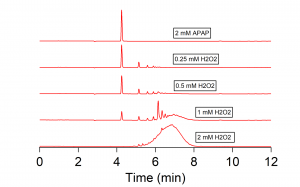
Utilizing HRP as a model enzyme for CYPs' oxidation of APAP in the liver indicates the formation of increasingly nonpolar APAP conjugates in the form of polymers.
References
1. Potter, DW; Miller, DW; Hinson, JA. Identification of acetaminophen polymerization products catalyzed by horseradish peroxidase. Journal of Biological Chemistry, 260,22 (1985). 12174-2180. Print
2. Dahlin, DC; Miwa, GT; Lu, AYH; Nelson, SD. N-acetyl-p-benzoquinone imine: a cytochrome P-450-mediated oxidation product of acetaminophen. Journal of Biochemistry, 81 (1984). 1327-1331. Print
3. West, PR; Harman, LS; Josephy, PD; Mason, RP. Acetaminophen: enzymatic formation of a transient phenoxyl free radical. Biochemical Pharmacology, 33(18) (1984) 2933-2936. Print
